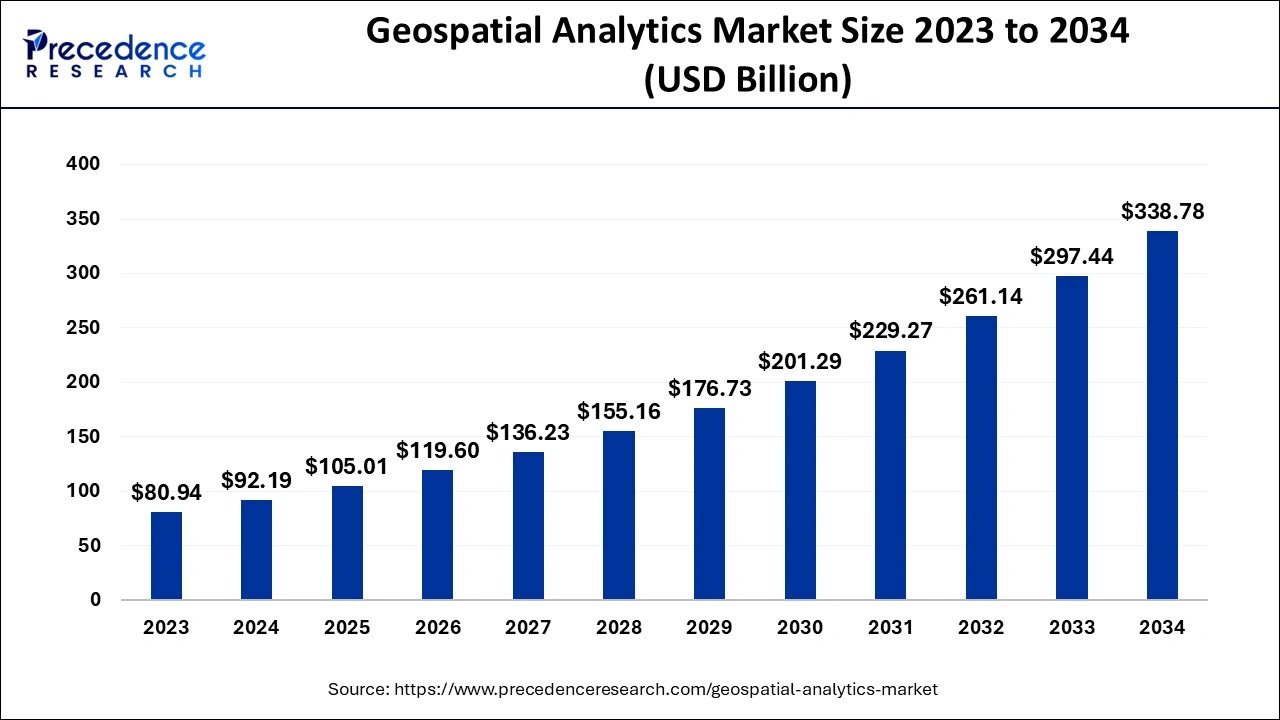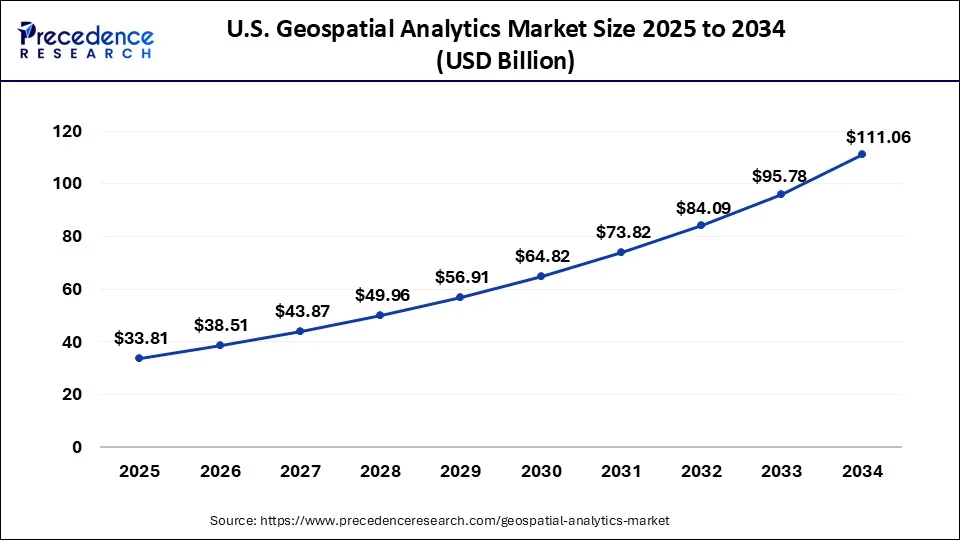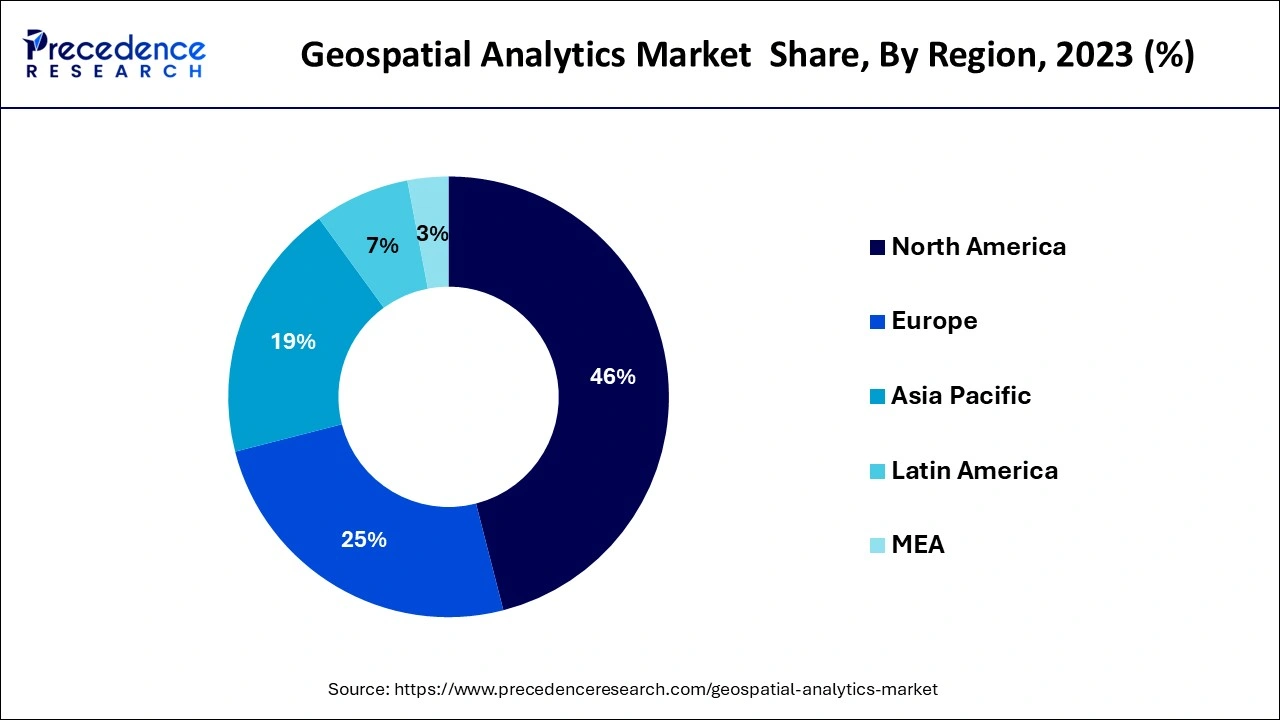October 2024
The global geospatial analytics market size is accounted for USD 92.19 billion in 2024 and is predicted to increase from USD 105.01 billion in 2025 to approximately USD 338.78 billion by 2034, growing at a CAGR of 13.90% from 2025 to 2034

AI is bringing a revolution into geospatial analytics processes by improving data processing accuracy, efficiency, and predictiveness. It can study huge datasets in real time, developer strategic decision-making. AI supports predictive models, trend scoping for better risk assessment, planning, and forecasting. Automation of repetitive processes comes with cost and efficiency benefits. It also helps uncover opportunities and yields results by spotting complex patterns in geospatial data. This provides industries with more significant insights, quicker humanities, and better strategies-from allocation of resources toward city planning and environmental monitoring.
The U.S. geospatial analytics market size is evaluated at USD 29.69 billion in 2024 and is predicted to be worth around USD 111.06 billion by 2034, rising at a CAGR of 14.09% from 2025 to 2034

Asia-Pacific dominated the geospatial analytics market in 2024. China and India dominated the geospatial analytics market in Asia-Pacific region. The growth of geospatial analytics market in Asia-Pacific region is being driven by the growing government initiatives. The Chinese government launched its first thorough geography census in 2018. It will be used to report on the country's overall position as well as statistics on land and soil, water, and agriculture, which will serve as a firsthand reference for policies. In addition, the growing trend of mobility as service facility is also boosting the growth of Asia-Pacific geospatial analytics market. Morgan Stanley estimates that shared miles will account for 35 percent of all miles travelled in India. Along with a continuing huge shift in terms of electrification, sharing, and connectivity, this is one of the primary driving opportunities for new business models in the mobility business.

North America, on the other hand, is expected to develop at the fastest rate during the forecast period. The U.S. dominates the geospatial analytics market in North America region. One of the key drivers driving the growth of North America geospatial analytics market is the growing adoption of innovative and latest technologies such as internet of things, big data analytics, artificial intelligence, and cloud computing. Furthermore, the rising demand for high-speed internet is also supporting the growth of North America geospatial analytics market.
| Report Coverage | Details |
| Market Size by 2034 | USD 338.78 Billion |
| Market Size in 2025 | USD 105.01 Billion |
| Market Size in 2024 | USD 92.19 Billion |
| Growth Rate from 2025 to 2034 | CAGR of 13.90% |
| Base Year | 2024 |
| Forecast Period | 2025 to 2034 |
| Segments Covered | Component, Type, Solution, Technologies, Deployment Mode, Organization Size, Application, and Region. |
| Regions Covered | North America, Europe, Asia-Pacific, Latin America and Middle East & Africa |
Procurement of geospatial analytics includes services, software, hardware, and data procurement that enable organizations to analyze geographical data for insights, to optimize operations, and support decision-making processes. Key players: Google and Microsoft
Geospatial analytics operations may comprise analysis of spatial data involving single-layer queries, multi-layer operations (overlay and modeling), network analysis, and surface analysis to spell out patterns, predict outcomes, and make decisions.
Key players: Oracle, Maxar Technologies
Technology development in geospatial analytics would mean continuing development of tools and techniques used for the collection, processing, and analysis of location-based data.
Key players: Esri, Trimble, Hexagon AB
Marketing and sales for geospatial analytics are focused on location-based insights services to companies and organizations so that they can make smarter decisions and work efficiently.
Key players: Alteryx and Maxar Technologies
The regulatory landscape of geospatial analytics has to do with an elaborate and ever-changing set of laws, policies, and ethical standards dealing with privacy, data ownership, licensing, and national security.
Key players: Esri, Hexagon AB, Trimble
The software segment dominated the geospatial analytics market in 2024. Enterprises can use geospatial analytics software to locate, evaluate, and respond to changing business circumstances and trends. The market players have commenced to involve in geospatial analytics in order to enhance suppleness and overall operational output, better comprehend business trends, and reduce expenses. The software sector can be thought of as the most advantageous component for generating high-level insights from location data.
The service segment is the fastest growing segment of the geospatial analytics market in 2024. Analytics are being used by government agencies and public safety organizations to monitor natural resources, infrastructure projects, detect cross-border incursions, and improve vehicle safety and security. Businesses are also providing Geospatial Analytics-as-a-Service.
The surface and field analytics segment dominated the geospatial analytics market in 2024. The growth of surface and field analytics segment is attributed to the rising acceptance and adoption by private and government firms. In addition, the growing number of infrastructure development projects are also supporting the growth of the overall market.
The network and location analytics segment is fastest growing segment of the geospatial analytics market in 2024. The technology aids in the improvement of data analytics' functionality, utility, and relevance. It can also analyze and organize enormous amounts of data in real time in order to obtain actionable business insights. It also enables marketers to visualize, comprehend, and interpret data in a variety of ways to demonstrate links, trends, and patterns using globes, maps, charts, and reports. This is critical for every business that wants to grow, expand into new markets, and satisfy customers.
The military intelligence segment dominated the geospatial analytics market in 2024. Strategic intelligence plays an important role in modern military strategies. Strategic intelligence relies heavily on geospatial data. Many countries are constantly strengthening their military as a result of current military confrontations between big economies. Border security operations can use geospatial data to give situational awareness information, enabling quick decision-making, and improve national security.
The surveying segment is fastest growing segment of the geospatial analytics market in 2024. This is due to its widespread adoption in agricultural and natural resource monitoring. During the projected period, however, the military intelligence segment is expected to increase at the quickest rate. This could be due to an increase in the number of remote sensing satellites used for border patrols around the world, necessitating the usage of geospatial analytics.
By Component
By Type
By Solution
By Technologies
By Deployment Mode
By Organization Size
By Application
By Region
For inquiries regarding discounts, bulk purchases, or customization requests, please contact us at sales@precedenceresearch.com
No cookie-cutter, only authentic analysis – take the 1st step to become a Precedence Research client
October 2024
July 2025
July 2025
July 2024